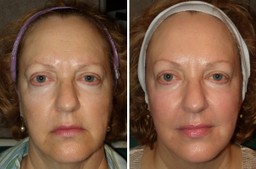As I’ve written in the past, we are very social beings and we yearn to connect with one another. Unfortunately, sometimes through birth and sometimes with age, our faces can convey a message that is inconsistent with the way we feel inside.
This miscommunication can occur when heavy upper lids or baggy lower lids with Festoons or Malar Mounds make us appear tired, sick or older than we really are. It can also occur when our inner brow furrows and the corners of our mouth starts to droop.
I recently saw a video featuring a comedian speaking about her “Bitchy Resting Face.” In it, she woman made fun of the fact that people are sensitive to each other’s facial expressions, and especially so when the corners of the mouth droop, making them look “bitchy” to others. But this condition isn’t just a joke; in my practice, patients have expressed to me how they dislike what they call their “Older Bitchy Face.”
Although the video above is funny, it points to something I’ve been writing and speaking about for years: We are internally driven to connect with one another and build social relationships, and our faces are our biggest tool in nonverbal communication. When (due to age or by birth) the corners of a person’s mouth point downwards, this can make them appear mad, angry or sad.
Take a look at this photo of this patient of mine. People often thought she was upset, which concerned her because she usually felt fine inside.
Her internal emotional state was not in balance with the message her face was sending. Her nonverbal communication was discordant with how she truly felt.
The Science Behind “Bitchy Resting Face”
When we see one another, our subconscious brain scans the other person’s face for facial cues. Our subconscious brain then informs our conscious brain as to how we should feel about what we just saw in this area.
Although down-turned corners of the mouth can be seen in certain younger individuals (which we will discuss shortly), the vast majority of these cases occur as people age.
As we age, our faces change in a three-dimensional way through changes in our bones, facial fat and skin layer. A down-turned mouth is based in changes that occur in our teeth and jaw. With age, our jaw starts to rotate backwards, and as it falls back into the deeper face, the skin around this area falls backwards as well.
In this photo, you can see the increase in the openness of the skeleton around the nose. The folds we see around the nose to the mouth (known as nasolabial folds) are actually a result of the nose falling into the face.
In this photo, you can see the deeper bony changes that cause these folds (melolabial folds or “puppet lines”) to develop from the corners of the mouth to the jaw line.
It is this folding inwards that causes the corner of the mouth to droop and makes us appear mad, sad and—for lack of a better word—“bitchy.”
Treatment Is Available
For older individuals with this facial appearance, it is up to them whether they are comfortable with the messages their face is sending to the outside world. If they are frustrated with the down-turned corners around their mouth, I perform a procedure called a RadiantLift® that is very effective in improving down-turned mouth corners and restoring a refreshed appearance to this part of the face that is so important for nonverbal communication. It’s a nonsurgical, quick office treatment to improve lost facial volume and freshen up sun-aged skin.
Consider the change your our mind sees in these two photos below, which are before and after shots of a patient who has undergone my RadiantLift® procedure. Which person would you rather approach and say hello to at a party?
After her treatment with me, this patient mentioned that others were commenting on how energetic, youthful and approachable she now appeared.
When younger individuals have issues with down-turned corners of the mouth, it is usually related to an over-action of the depressor anguli oris muscle.
Above photography, text and labels by Rob Swatski, Assistant Professor of Biology, Harrisburg Area Community College – York Campus, York, PA. Email: rjswatsk@hacc.edu
Now, while it is up to each individual to chose whether they feel comfortable with the messages their face is sending to the outside world, if a younger person with an overactive depressor anguli oris muscle wanted to reverse a “Bitchy Resting Face,” a small amount of a neuromodulator is often effective in reversing a down-turned mouth in younger patients.
It’s All About How You Communicate With the World
Although we like to think we are independent thinkers and our conscious brain controls our world, in reality, we are greatly affected by our subconscious brain—and it tends to like certain ratios and balance in the face. When a face is out of balance with what our subconscious brain appreciates, it influences and colors our impressions of this person. This is the real reason we intuitively see a down-turned mouth as a sign of sadness or anger, regardless of how the person sending forth this image actually feels.
We are biologically driven to evaluate each other based on appearances, as recent research supports, and this is why we see certain faces as “bitchy.” Evolutionarily speaking, our brains evolved to be able to quickly evaluate facial expressions to determine if a person was a friend or a threat. As we age, our conscious brain tends to have greater control over our impressions, but our subconscious brain still has huge sway in how we interpret the world. It’s been said that we see things and experience things emotionally and then rationalize them intellectually.
The subconscious brain is the basis of those emotions. Although I wish we all evaluated each other solely on basis of our actions and speech, in reality we all are greatly affected by the facial messages and nonverbal communication sent forth by others.
Rather than ignoring this fact, I love helping my patients optimize their nonverbal communication so that others in the world can relate to them in a better way. Helping patients restore, reveal and reclaim their natural beauty gives me great joy in my practice.










